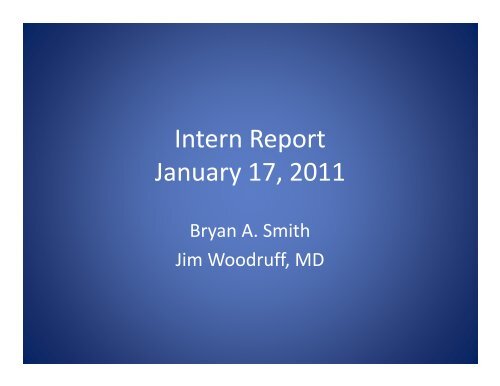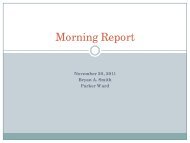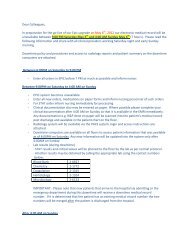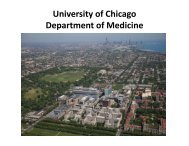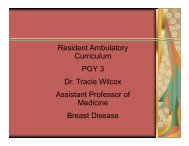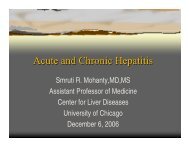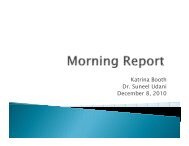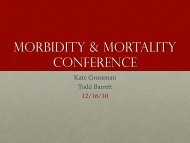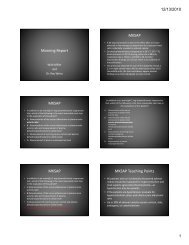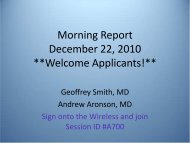IR Acute Hepatitis B
IR Acute Hepatitis B
IR Acute Hepatitis B
Create successful ePaper yourself
Turn your PDF publications into a flip-book with our unique Google optimized e-Paper software.
Intern Report<br />
January 17, 17 2011<br />
Bryan A. Smith<br />
Jim Woodruff, MD
Case<br />
• 68yo M presents with jaundice and decreased<br />
appetite x 1 mo. mo<br />
Questions?
More Info<br />
• Began g feeling g sick 1 mo ago g after being g treated with<br />
cipro for UTI<br />
• Described symptoms of fever, chills, night sweats,<br />
llethargy, h decreased d dappetite, ddark kcolored l durine and d<br />
light stools<br />
• One week previous, previous presented to OSH for laser<br />
procedure to relieve prostate obstruction. Since then<br />
has had bladder incontinence, dark red urine, clay<br />
colored stools<br />
• Patient reports weight loss of 10lbs in 1 mo
• PMHx<br />
– PProstate t t ca‐ s/p / XRT<br />
– Islet cell tumor of pancreas s/p<br />
resection ‘06<br />
– HTN<br />
– BPH<br />
– DM‐ insulin dependent<br />
• PSHx<br />
• Distal pancreatectomy/<br />
splenectomy ’06‐ lymph nodes<br />
neg, surgical margins free of dx.<br />
• NKDA<br />
• FHX<br />
– noncontributory<br />
Case (cont)<br />
• Social<br />
– Li Lives with ith wife if<br />
– Retired, once worked in<br />
pharmaceutical sales<br />
– +tob‐ 25 pack‐years, social EtOH,<br />
no illi illicits i<br />
• Meds<br />
– Enalapril 20mg BID<br />
– Nifedipine p 90mg g dailyy<br />
– Sildenafil 100mg daily<br />
– Flomax 0.4mg daily<br />
– Finasteride 5mg daily<br />
– Glipizide 10mg daily<br />
– Lantus
Differential?
Classification of Jaundice<br />
UUnconjugated j t dHHyperbilirubinemia bili bi i CConjugated j t dHHyperbilirubinemia bili bi i<br />
• Increased bilirubin production • Biliary Obstruction<br />
– Extravascular hemolysis<br />
– Et Extravasation ti of f bl blood d iinto t<br />
tissues<br />
– Intravascular hemolysis<br />
– Dyserythropoiesis<br />
y y p<br />
• Impaired Hepatic Uptake<br />
– Heart Failure<br />
– Portosystemic Shunts<br />
– Drugs<br />
– Gilbert’s Syndrome<br />
• Impaired conjugation<br />
– Cil Crigler‐Najjar Njj SSyndrome d<br />
– Gilbert’s Syndrome<br />
– Hyperthyroidism<br />
– Liver dx‐ dx chronic hepatitis,<br />
advanced cirrhosis, Wilson’s<br />
disease<br />
– Choledocholithiasis<br />
– Intrinsic and Extrinsic tumors<br />
– Primary Sclerosing Cholangitis<br />
– AIDS cholangiopathy<br />
– <strong>Acute</strong>/ chronic pancreatitis<br />
– SStrictures‐ i s/pprocedures<br />
/ d<br />
– Parasitic infection<br />
• Intrahepatic cholestasis<br />
– Viral <strong>Hepatitis</strong><br />
– Alcoholic hepatitis<br />
– Nonalcoholic steatohepatitis<br />
– Primary biliary cirrhosis<br />
– Drugs/ toxins<br />
– Sepsis<br />
– Infiltrative dx (amyloid, lymphoma, sarcoid,<br />
TB)<br />
– ESLD<br />
• Hepatocellular Injury
Physical Exam<br />
• Vitals: T: 37.4 P: 72 R: 18 BP: 158/74 O2sat: 97%RA<br />
• GEN: NAD, well nourished<br />
• HEENT: Scleral icterus, sublingual jaundice, moist mucus<br />
membranes membranes, no oropharyngeal erythema/ exudate exudate, no LAD LAD,<br />
no JVD<br />
• CV: S1, S2, no MRG, RRR, PMI 5th ICS<br />
• PULM: CTAB, normal respiratory effort<br />
• GI: RUQ and epigastric mild TTP, soft, non‐distended, no<br />
appreciable appecabeoga organomegaly, o egay, no o spider sp de angiomas a go as<br />
• Neuro: A & O x 3, CN II‐XII intact, no asterixis<br />
• Extremities: 2+ pulses, warm, well perfused, no LE edema
Evaluation of Jaundice<br />
• 80% daily bilirubin<br />
production from hemoglobin<br />
• Normal serum concentration<br />
of bilirubin < 1mg/dL g/<br />
• Clinician cannot detect<br />
jaundice until bilirubin ><br />
2.0mg/dL<br />
• Jaundice seen best in ocular<br />
conjunctiva and in oral<br />
mucus membranes (under<br />
tongue, hard palate), and in<br />
the skin.
Wh What labs lb would ld you lik like to order?<br />
d ?
133 101 13<br />
3.8 22 1.0<br />
Labs and Studies<br />
166<br />
8.0<br />
2.1<br />
28 2.8<br />
11.9<br />
92 9.2 278 UA UA‐ + leuk esterase<br />
33.1<br />
N‐ 71<br />
LL‐ 14<br />
M‐ 15<br />
MCV‐ 86.2<br />
MCH MCH‐ 31<br />
MCHC‐ 36.0<br />
+ nitrite<br />
2+ protein<br />
3+ blood<br />
3+ bilirubin<br />
E‐ 0 RDW‐ 21.8 ‐ glucose<br />
B‐0<br />
trace ketones<br />
PT‐ 17.8<br />
INR‐ 1.4<br />
7.1 2.9<br />
21.0 16.4 / 4.6<br />
994 1153<br />
218<br />
GGT‐ 351<br />
Lipase‐ 47<br />
Ammonia‐ 96
Wh What else l would ld you lik like to order?<br />
d ?
• RUQ U/S<br />
Additional Studies<br />
– Partially distended gallbladder with gallbladder<br />
wall thickness thickness. Sludge and gallstones within the<br />
gallbladder noted.<br />
– No hepatic vein thrombosis, no hepatomegaly, no<br />
Budd‐Chiari syndrome
OSH workup arrives..<br />
• CT abdomen/ pelvis w/ contrast‐ contrast<br />
– s/p splenectomy and post op changes in uper abd<br />
with clips in area of pancreas pancreas. No residual masses masses.<br />
Thickening of gallbladder wall, may be 2/2 ascites.<br />
No free air, no bowel obstruction.
Additional Labs<br />
• Blood cx‐ negative • <strong>Hepatitis</strong> Panel<br />
• Urine cx‐ negative<br />
• AAnti‐mitochondrial ti it h d i l ab b ‐
<strong>Hepatitis</strong> B<br />
• Affects 1.25 million people in the US and 350‐400 million worldwide<br />
• After WHO recommended hep B vaccine included in infant immunization in 1992,<br />
incidence has dropped from 252,000 to 51,000 cases annually in the US<br />
• 0.1 ‐ 0.2% carriers in low prevalence areas‐ U.S., Canada, Western Europe<br />
• 10‐20% carriers in high prevalence areas‐ southeast Asia, China, sub‐Saharan Africa<br />
• In low prevalent areas, most acute HBV infections occur during adolescence or<br />
early adulthood due to risky behavior<br />
• In high prevalent areas, perinatal transmission results in chronic infection in 90%
Risk Factors<br />
• High Prevalent Areas‐ Perinatal transmission most<br />
common and vertical transmission as high as 90%<br />
• Intermediate Prevalence Areas‐ common age 1‐5<br />
– Horizontal transmission common via breaks in skin and<br />
mucous membranes, close body contact<br />
• Low prevalence areas‐ most common age 25‐44<br />
– SSexual liintercourse t with ith iinfected f t diindividual di id l<br />
• Heterosexual transmission‐39%<br />
• MSM‐ 24%<br />
– IV ddrug use‐ 16%<br />
– Others‐ accupuncture, tattoo, body piercings<br />
– Blood transfusion‐ risk 1:63,000
• Belongs to<br />
hepadnavirus family<br />
• Genome‐ Genome relaxed<br />
partially dsDNA<br />
replicates by reverse<br />
transcriptase<br />
<strong>Hepatitis</strong> B Virus<br />
• Comprised of envelope of viral encoded proteins<br />
(HBsAg) and core of nucleocapsid protein (HbcAg),<br />
viral genome, DNA polymerase protein
<strong>Acute</strong> <strong>Hepatitis</strong> B<br />
• Exposure‐ HBV enters bloodstream, circulates to liver<br />
• Incubation period‐ Pt is asymptomatic, normal liver transaminases<br />
– HBV replicates within hepatocytes, immune response initiated, HBV DNA rises<br />
– May last 1‐6mo, with avg duration of 60 days<br />
• Prodrome‐ non‐specific symptoms of anorexia, malaise, nausea, vomiting, abd pain<br />
• <strong>Acute</strong> phase‐ 70% have subclinical hepatitis, while 30% develop icteric hepatitis<br />
– Avg time from infection to jaundice 90 days.<br />
– Labs reveal elevations in AST and ALT up to 1000‐2000 IU/L, with ALT>AST<br />
• Resolution‐ Associated with decline in liver transaminases and symptomatic resolution<br />
– Transaminases normalize within 2‐8 weeks<br />
– Among those who recover, virus cleared by antiviral antibodies and cytotoxic T lymphs<br />
– Resolution associated with elimination of virus and appearance of anti‐ HBs, conferring<br />
lifelong immunity from re‐infection
Serologic Markers<br />
• HBsAg‐ serologic hallmark of infection (acute and chronic)<br />
– Detectable after 4‐10wk incubation period before symptoms and rise in ALT<br />
– Typically becomes undetectable after 4‐6mo<br />
– Persistence >6mo implies chronic hep B<br />
• Anti‐HBs‐ Follows disappearance of HBsAg and persists for life<br />
– May not be detectable during window period for few weeks –months during which<br />
no HBsAg or anti‐HBs are detectable<br />
• HBcAg‐ intracellular antigen expressed in hepatocytes but not expressed in serum<br />
– Can be detected by immunohistochmical staining of liver histological specimens<br />
• IgM anti‐HBc‐ shortly follows HBsAg positivity<br />
– Positive during window period‐ HBsAg undetectable and anti‐HBs may not be positive<br />
– Indication of acute HBV infection<br />
– May remain detectable up to two years after acute infection<br />
– May also be positive in exacerbations of chronic HBV<br />
• IgG anti‐HBc‐ persists for life in pt with acute or chronic HBV infection
Serologic Markers (cont)<br />
• HBeAg‐ protein marker indicating HBV replication and infectivity<br />
– Associated with high levels of HBV DNA in serum and high rates of<br />
transmission from carrier mothers to babies<br />
– HBeAg seroconversion to anti‐Hbe occurs early in acute HBV, typically<br />
before HBsAg seroconversion to anti anti‐ HBs<br />
– Seroconversion may take months to years in pt with chronic HBV but<br />
indicates decrease of serum HBV DNA and remission<br />
• HBV DNA<br />
– Most assays use real time PCR, reporting in IU/mL<br />
– Recovery from acute hepatitis accompanied by disappearance of HBV<br />
DNA in i serum<br />
– Low levels HBV DNA detectable in the blood for many years
<strong>Acute</strong> <strong>Hepatitis</strong> B Treatment<br />
• Treatment for acute HBV mainly supportive‐ progression to fulminant hepatic<br />
failure
Over course of admission…<br />
• Pt spiked daily fevers to 38.9 thought to be 2/2 hep B. Blood<br />
cultures lt remained i dnegative, ti no other th source of f acute t infection. i f ti On O<br />
ceftriaxone x 3 days for UTI.<br />
• Symptomatic improvement‐ abdominal pain resolved, nausea<br />
resolved resolved, pt able to tolerate PO<br />
• Total bilirubin trended from 21.0 19.1, ALT 1153 1060, AST<br />
994 916<br />
• GI consult‐ consult no additional w/u indicated, follow up as outpatient<br />
with symptomatic management for acute hepatitis B<br />
• Surgery consult signed off<br />
• UTI‐ pt p ggiven 3 days y of ceftriaxone and d/cwoabx /<br />
• Source of infection remained unclear‐ pt denies any risky sexual<br />
behavior, IVDU, recent blood transfusions, etc.
2 week follow up<br />
• Total bilirubin: 21.0 7.4<br />
• ALT 1153: 144<br />
• AST: 994 71<br />
• Albumin: 2.9 3.5<br />
• H<strong>Hepatitis</strong> titi B viral i llload: d 282199 247<br />
• Still admits to dark urine and some fatigue but<br />
abd bd pain i resolved l dand d feeling f li much h better btt<br />
• Regular follow up per GI
Take Home Points<br />
• Most acute <strong>Hepatitis</strong> p B infections are self‐limiting g and<br />
will resolve with symptomatic management in 6mo 6<br />
• Active infections need follow up in clinic to trend<br />
transaminases, bilirubin, and serology<br />
• Pts should refrain from sexual activity until they<br />
develop anti‐HBs, which may take up to 6mo<br />
• Those with chronic hepatitis B have increased risk of<br />
developing cirrhosis and hepatocellular carcinoma
Thanks!<br />
Questions?


